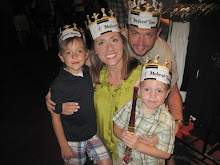There are few things more frightening than awakening to the sound of your child's terror-filled shrieks and cries. Many parents of preschoolers experience this night after night as their children suffer with bouts of nightmares. According to ParentCenter.com, "2- to 4-year-olds are particularly prone (to nightmares) — this is an age when normal fears develop, imagination blossoms, and the ability to describe a bad dream kicks into high gear." Researchers divide sleep disturbances into two categories: night terrors and nightmares.
Night Terrors
Night terrors occur 3-5 hours after the child has fallen asleep, according to Yahoo Health, and cause children to cry intensely and often lose their breath, which can frighten parents. Children never fully awaken and will have no recollection of the event the next morning.
Common knowledge suggests parents simply keep their child safe and allow the terror to run its course (usually 10-30 minutes). However, Dr. Alan Greene theorizes a connection exists between night terrors and a child's ability to recognize overnight bladder control. He suggests children experiencing a night terror should be taken to the restroom.
Parents may be able to limit the frequency of night terrors by making sure their child gets plenty of sleep and creating a calming bedtime routine.
Nightmares
Nightmares typically occur in the second half of sleep and are simply frightening dreams. In a classic sleep study conducted in 1966, researchers studied sleep waves in newborns, infants, toddlers, and preschoolers and proved that children at each age dream. This led them to conclude that children at every age also have nightmares. Nightmares seem more prevalent at the preschool age because children have developed the ability to fear, the experience to know normal from unnatural, and the language to describe what they experience.
ParentCenter.com suggests treating nightmares with physical reassurance. Comfort the child and allow him to tell you about the nightmare if he wants. Make sure his favorite toy or blanket is snuggled in close. Then reassure him that you are right down the hall and will protect him. However, Yahoo Health warns to keep these visits consistent. "Sleep problems often become worse if the child is rewarded with attention."
Parents can help prevent nightmares by guarding what children watch on TV or the stories they hear. Also, allowing children to talk through the details of their day helps them process scary events or new emotions during waking hours. Guide children through stressful times like potty training, transitioning to a big bed, or starting school.
ParentCenter.com provides the following creative preventative measures for consistent mightmares:
Parents can be reassured the night terrors and nightmares are a normal stage of childhood development.
Night Terrors
Night terrors occur 3-5 hours after the child has fallen asleep, according to Yahoo Health, and cause children to cry intensely and often lose their breath, which can frighten parents. Children never fully awaken and will have no recollection of the event the next morning.
Common knowledge suggests parents simply keep their child safe and allow the terror to run its course (usually 10-30 minutes). However, Dr. Alan Greene theorizes a connection exists between night terrors and a child's ability to recognize overnight bladder control. He suggests children experiencing a night terror should be taken to the restroom.
Parents may be able to limit the frequency of night terrors by making sure their child gets plenty of sleep and creating a calming bedtime routine.
Nightmares
Nightmares typically occur in the second half of sleep and are simply frightening dreams. In a classic sleep study conducted in 1966, researchers studied sleep waves in newborns, infants, toddlers, and preschoolers and proved that children at each age dream. This led them to conclude that children at every age also have nightmares. Nightmares seem more prevalent at the preschool age because children have developed the ability to fear, the experience to know normal from unnatural, and the language to describe what they experience.
ParentCenter.com suggests treating nightmares with physical reassurance. Comfort the child and allow him to tell you about the nightmare if he wants. Make sure his favorite toy or blanket is snuggled in close. Then reassure him that you are right down the hall and will protect him. However, Yahoo Health warns to keep these visits consistent. "Sleep problems often become worse if the child is rewarded with attention."
Parents can help prevent nightmares by guarding what children watch on TV or the stories they hear. Also, allowing children to talk through the details of their day helps them process scary events or new emotions during waking hours. Guide children through stressful times like potty training, transitioning to a big bed, or starting school.
ParentCenter.com provides the following creative preventative measures for consistent mightmares:
• Help your child make a Native American dreamcatcher out of pipe cleaners or draw one on construction paper, and hang it over the bed to snare bad dreams and let only the good ones through.
• Let him rub a little skin lotion or face cream — you might call it "good dream cream" — on his tummy or forehead before turning in for the night.
• Fill a spray bottle with water scented with a couple drops of vanilla extract ("monster spray" or "nightmare repellent") and let your child banish scary dreams by spritzing a little around his room before bed.Parents can be reassured the night terrors and nightmares are a normal stage of childhood development.


I guess this explains Patriot's nightmares. Are you going to try a dreamcatcher or one of the other suggestions?
He really likes to rub on lotion, so I thought I might try that suggestion. He hasn't had another nightmare this week, though, so I'm hoping we won't need it.